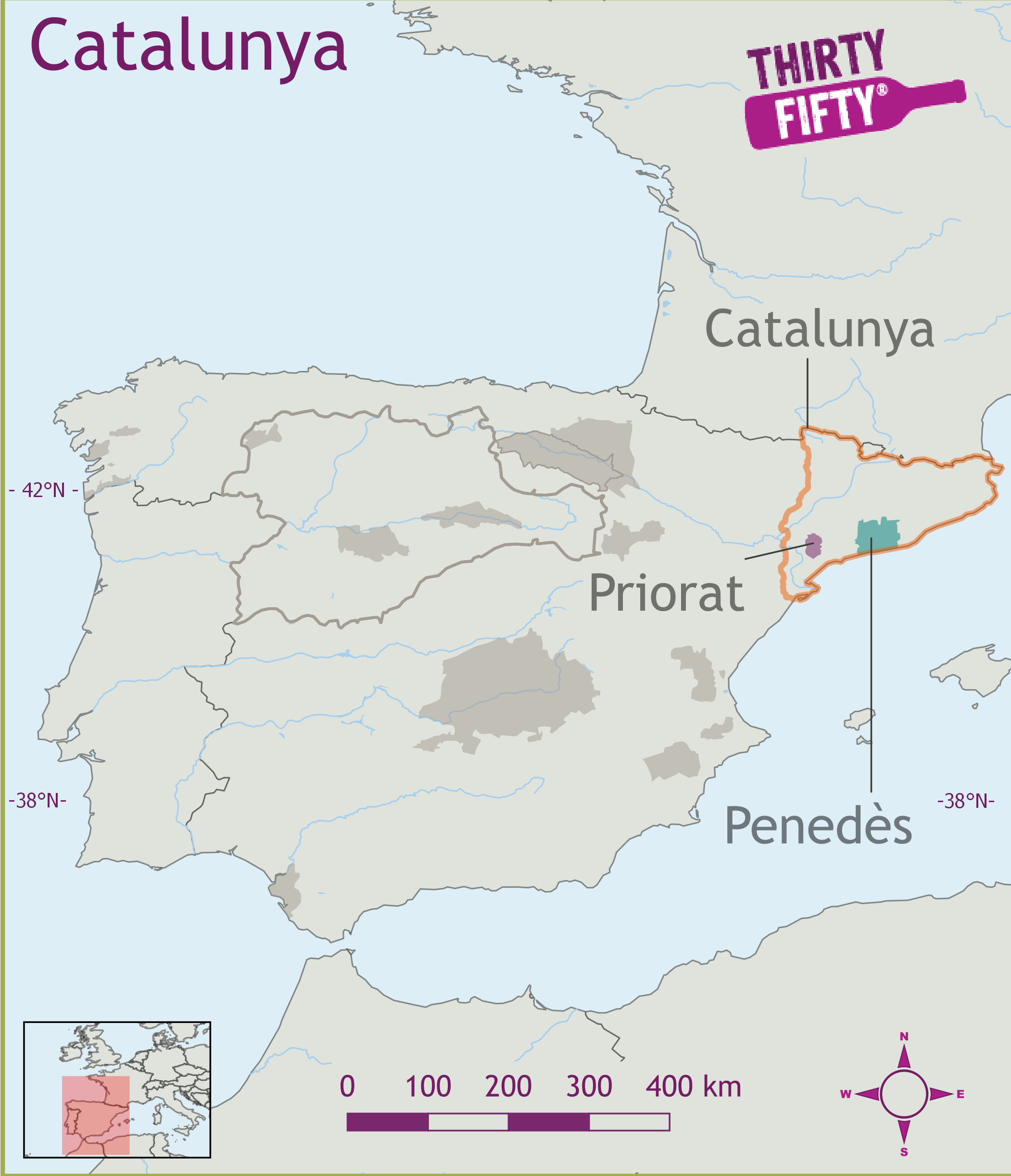Catalunya's Grapes: Cabernet Sauvignon, Cariñena, Chardonnay, Garnacha, Merlot, Tempranillo
Cabernet Sauvignon
Cabernet Sauvignon is perhaps the most famous red grape. Its home is Bordeaux where it is was created as a cross between Cabernet Franc (red grape) and Sauvignon Blanc (white grape). Since then its popularity has spread and it is grown all around the world. It prefers warmer climates to ripen fully and even in Bordeaux some years it does not ripen. That is why Cabernet Franc is also used in Bordeaux blends as it ripens faster. What makes Cabernet so popular is not its bouquet, which can range from blackcurrants to cigar box, but its structure, typically having both tannins and acidity to create a smooth feeling in the mouth. The structure allows the blending with other grapes, perhaps the most famous pairing is Cabernet Sauvignon and Merlot where the Cabernet provides the structure and the Merlot gives the wine the soft, rounded feel in the mouth. Recently Cabernet has been mixed with Sangiovese (Chianti's grape) to create the SuperTuscans.
Cariñena
Chardonnay
Jancis Robinson described Chardonnay as the tart of the grape world, as it would lie down anywhere and do what the winemaker told it to do! In other words it will grow almost anywhere and produce decent and quite stylistically different wines ranging from minerally Chablis, Champagne, buttery fruit wines, tropical fruit wines or oaky vanilla wines. During the late 1990's Chardonnay was the drink of choice for many. However people became bored with the oaky wines found in so many bars and the term, 'ABC' (Anything but Chardonnay) came about. The ubiquitous yet noble Chardonnay grape has virtually become a brand name. From its homeland in Burgundy, its fame and fortune have taken it all over the world. It�s grown on different soils in varying climates to be used either as a single varietal or in blends, for still and sparkling wines, and with or without oak ageing to create a wide range of wines with diverse personalities. As a result, it�s impossible to describe a typical Chardonnay. For a start, the grape can make anything from an everyday glugger to a high-quality wine deserved of ageing. Its popularity in the vineyard stems from the fact that it�s easy to grow, consistently yielding generously with relatively high sugars (and, therefore, alcohol). In the winery its advantages are obvious � it�s difficult to make a poor wine from it, unless it�s been picked too late, because then its acid levels fall quickly, which make it flabby. Chardonnay isn�t strongly aromatic: some detect anything from apples (or barely ripe apples in Chablis) and melon in Maconnais Chardonnay to tropical fruit flavours in New World examples. Common descriptives, however, tend to refer to texture and weight rather than flavour � buttery for broader styles, such as Meursault from the Cote de Beaune; steely for Montrachets and nutty for Corton-Charlemagne. There�s an attractive leanness to fine Cote d�Or white burgundy, that sets it apart from Chardonnays from the rest of the world, but this can be emulated further south in the Cote Chalonnaise and Maconnais in good vintages with clever winemaking.
Garnacha
Merlot
Merlot makes luscious, smooth and fruity wines. In spite of this, it�s still perceived as one of the vine world�s great underdogs, most often being unfavourably compared to prized Cabernet Sauvignon, its more austere and frequent blending partner. Planted throughout South West France and much of the rest of the world, Merlot means �little blackbird� in Bordeaux patois, and was so-called because it was said that it�s the grape the blackbird guzzles first and that the bird�s colour resembles the grapes. It produces its most glorious wines in St-Emilion and Pomerol, on the right bank of the Gironde, including Bordeaux�s most expensive wine, Chateau Petrus. Chile's soft plum aromas are a favourite to many consumers. Merlot can adapt to a wide range of soils and microclimates, but it buds, flowers and ripens relatively early, so spring frosts are a danger. Its thin-skinned grapes are also liable to rot in wet vintages. However, Merlot�s lowish fruit tannins make it an excellent early-drinking wine.
Tempranillo
Tempranillo is Spain�s answer to Cabernet Sauvignon and one of the most important black grapes used for making Rioja. It takes its name from temprano, Spanish for �early�, because it usually ripens early � and certainly a good two weeks before Rioja�s other important grape Garnacha. This relatively short growing cycle makes Tempranillo able to thrive in the often harsh climate of Rioja�s higher, more Atlantic-influenced zones Rioja Alta and Rioja Altavesa. Although it produces deep-coloured wines, it doesn�t have a particularly strong flavour identity and is quite low in acidity so, alone, the wines lose their fruit and liveliness after a few years. This is the reason a high proportion is blended with juicier, more perfumed varieties (which in Rioja are Garnacha, Mazuelo, Graciano and Viura) to produce wonderful wines capable of ageing. It prefers deep calcareous or sandy clay soil and does best on slopes. In Spain, it�s known by many synonyms, including Tinto Fino, Tinto de Toro and Cencibel, although recent research by winemakers now suggests its namesakes are in fact different clones. Elsewhere, it�s grown in Portugal�s Alentejo as Aragonez and in the Douro as Tinta Roriz, as well as in Argentina and southern France.
PDO's & PGI's
- DO Catalunya
- DO Penedès
- DOCa Priorat
Catalunya
Key Grape Varieties: Cabernet Sauvignon, Cariñena, Chardonnay, Garnacha, Merlot, Tempranillo


